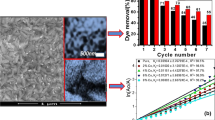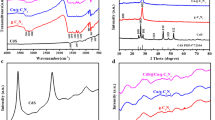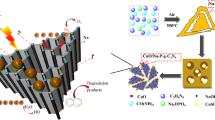Abstract
A metal chalcogenide-based heterojunction thin film has attracted much attention as a photocatalyst for various photocatalytic applications. One-step, ease of access, and low-cost chemical bath deposition technique has been applied to deposit Cu1–xCrxS layer onto the post-deposited CdS thin films for layer-by-layer structure. The prepared samples structural, morphological, elemental composition, and optical properties were also explored widely. The structural parameters of the CuS (sample A), Cu1–xCrxS (sample B), and CdS (sample D) thin films were assessed from the obtained X-ray diffraction (XRD) patterns. XRD pattern confirms the hexagonal wurtzite structure of samples A & B. The estimated parameters suggest that sample B shows better crystallinity. The optical bandgap of sample B shows the redshift effect on the Cr-doping. The sunlight-driven photocatalytic activity of sample A & B thin films was explored for the degradation of methylene blue (MB) dye aqueous solution without any oxidizing/reducing agent. The photodegradation results of sample B are better than the sample A. The redshift in optical absorption of sample B contributes to the enhancement in photocatalytic activity compared to sample A. Furthermore, the photocatalytic performance of sample A and B coupled with CdS (sample D) is examined. The cascade-like band structure between CdS and CuS accelerates the photocatalytic activity toward the degradation of methylene blue dye. The nanosheet-like morphology of CdS thin film provides a large surface area and a high number of active sites which also contributes in the performance enhancement of heterojunction thin films (sample AD and sample BD). The estimated rate constant of the sample BD compared to the sample AD is higher maybe due to the reduction in the recombination rate and separation of photogenerated ē-h+ pairs under the solar energy. The calculated photodegradation efficiency of sample BD is also higher than the sample AD. From the repeatability test of the samples AD & BD, the photocatalytic activity of the sample BD is still better than the sample AD, sample A & sample B. This work gives the primary ideology toward the efficient and low-cost fabrication of heterojunction thin-film photocatalyst.













Similar content being viewed by others
Data availability
The data used to support the findings of this study are included within the article.
References
T. Di, Q. Xu, W. Ho, H. Tang, Q. Xiang, J. Yu, Review on metal sulphide-based Z-scheme photocatalysts. ChemCatChem 11, 1394–1411 (2019). https://doi.org/10.1002/cctc.201802024
X. Ye, Y. Chen, C. Ling, J. Zhang, S. Meng, X. Fu, X. Wang, S. Chen, Chalcogenide photocatalysts for selective oxidation of aromatic alcohols to aldehydes using O2 and visible light: a case study of CdIn2S4, CdS and In2S3. Chem. Eng. J. 348, 966–977 (2018). https://doi.org/10.1016/j.cej.2018.05.035
L. Nie, Q. Zhang, Recent progress in crystalline metal chalcogenides as efficient photocatalysts for organic pollutant degradation. Inorganic Chemistry Frontiers. 4, 1953–1962 (2017). https://doi.org/10.1039/C7QI00651A
F. Haque, T. Daeneke, K. Kalantar-zadeh, J.Z. Ou, Two-dimensional transition metal oxide and chalcogenide-based photocatalysts. Nano-Micro Letters. 10, 23 (2017). https://doi.org/10.1007/s40820-017-0176-y
H. Zhou, T. Fan, T. Han, X. Li, J. Ding, D. Zhang, Q. Guo, H. Ogawa, Bacteria-based controlled assembly of metal chalcogenide hollow nanostructures with enhanced light-harvesting and photocatalytic properties. Nanotechnology 20, 085603 (2009). https://doi.org/10.1088/0957-4484/20/8/085603
B. Rani, S. Punniyakoti, N.K. Sahu, Polyol asserted hydrothermal synthesis of SnO2 nanoparticles for the fast adsorption and photocatalytic degradation of methylene blue cationic dye. New J. Chem. 42, 943–954 (2018). https://doi.org/10.1039/C7NJ03341A
Y. Liu, C. Luo, J. Sun, H. Li, Z. Sun, S. Yan, Enhanced adsorption removal of methyl orange from aqueous solution by nanostructured proton-containing δ-MnO2. J. Mater. Chem. A. 3, 5674–5682 (2015). https://doi.org/10.1039/C4TA07112C
K. Saravanakumar, V. Muthuraj, S. Vadivel, Constructing novel Ag nanoparticles anchored on MnO2 nanowires as an efficient visible light driven photocatalyst. RSC Adv. 6, 61357–61366 (2016). https://doi.org/10.1039/C6RA10444D
J. Li, P. Jiménez-Calvo, E. Paineau, M.N. Ghazzal, Metal chalcogenides based heterojunctions and novel nanostructures for photocatalytic hydrogen evolution. Catalysts. 10(1), 89 (2020). https://doi.org/10.3390/catal10010089
Y. Zhao, Y. Zuo, G. He, Q. Chen, Q. Meng, H. Chen, Synthesis of graphene-based CdS@CuS core-shell nanorods by cation-exchange for efficient degradation of ciprofloxacin. J. Alloy. Compd. 869, 159305 (2021). https://doi.org/10.1016/j.jallcom.2021.159305
W. Xu, S. Zhu, Y. Liang, Z. Li, Z. Cui, X. Yang, A. Inoue, Nanoporous CuS with excellent photocatalytic property. Sci. Rep. 5, 18125 (2015). https://doi.org/10.1038/srep18125
X. Yu, H. Chen, Q. Ji, Y. Chen, Y. Wei, N. Zhao, B. Yao, p-Cu2O/n-ZnO heterojunction thin films with enhanced photoelectrochemical properties and photocatalytic activities for norfloxacin. Chemosphere 267, 129285 (2021). https://doi.org/10.1016/j.chemosphere.2020.129285
Y. Wan, S. Du, C. Lu, K. Ren, B. Shi, S. Liu, C. Li, W. Dou, P. Fang, N. Ye, Metallic CuS decorated CdS nanowires for efficient photocatalytic H2 evolution under visible-light irradiation. J. Alloy. Compd. 871, 159461 (2021). https://doi.org/10.1016/j.jallcom.2021.159461
N. Qin, W. Wei, C. Huang, L. Mi, An efficient strategy for the fabrication of CuS as a highly excellent and recyclable photocatalyst for the degradation of organic dyes. Catalysts. 10(1), 40 (2020). https://doi.org/10.3390/catal10010040
M. Ahmad Pandit, S. Billakanti, K. Muralidharan, A simplistic approach for the synthesis of CuS-CdS heterostructure: a novel photo catalyst for oxidative dye degradation. J. Environ. Chem. Eng. 8, 103542 (2020). https://doi.org/10.1016/j.jece.2019.103542
L. Isac, C. Cazan, A. Enesca, L. Andronic, Copper sulfide based heterojunctions as photocatalysts for dyes photodegradation. Front. Chem. 7, 694 (2019)
Q. Li, X. Du, C. Xia, X. Wang, T. Yang, Y. Jiang, Z. Yang, D. Zhu, F. Yin, Fabrication and photocatalytic properties of nano CuS/MoS2 composite catalyst by dealloying amorphous Ti–Cu–Mo alloy. Appl. Surf. Sci. 467–468, 221–228 (2019). https://doi.org/10.1016/j.apsusc.2018.10.139
I. Vamvasakis, A. Trapali, J. Miao, B. Liu, G.S. Armatas, Enhanced visible-light photocatalytic hydrogen production activity of three-dimensional mesoporous p-CuS/n-CdS nanocrystal assemblies. Inorganic Chemistry Frontiers. 4, 433–441 (2017). https://doi.org/10.1039/C6QI00515B
P. Nandi, D. Das, ZnO/CdS/CuS heterostructure: a suitable candidate for applications in visible-light photocatalysis. J. Phys. Chem. Solids 160, 110344 (2022). https://doi.org/10.1016/j.jpcs.2021.110344
Q. Chen, M. Zhang, J. Li, G. Zhang, Y. Xin, C. Chai, Construction of immobilized 0D/1D heterostructure photocatalyst Au/CuS/CdS/TiO2 NBs with enhanced photocatalytic activity towards moxifloxacin degradation. Chem. Eng. J. 389, 124476 (2020). https://doi.org/10.1016/j.cej.2020.124476
I.M.S. Mohammed, G.M.M. Gubari, M.E. Sonawane, R.R. Kasar, S.A. Patil, M.K. Mishra, V.V. Kutwade, R. Sharma, Influence of pH on the physical properties of CdS thin film and its photosensor application. Appl. Phys. A 127, 597 (2021). https://doi.org/10.1007/s00339-021-04743-y
G.M.M. Gubari, S.M. Ibrahim Mohammed, N.P. Huse, A.S. Dive, R. Sharma, An experimental and theoretical study of Cu0.2Zn0.8S thin film grown by facile chemical bath deposition as an efficient photosensor. J. Elec. Mater. 47, 6128–6135 (2018). https://doi.org/10.1007/s11664-018-6491-3
R.S. Dhaka, A.K. Shukla, M. Maniraj, S.W. D’Souza, J. Nayak, S.R. Barman, An ultrahigh vacuum compatible sample holder for studying complex metal surfaces. Rev. Sci. Instrum. 81, 043907 (2010). https://doi.org/10.1063/1.3367302
N. Soltani, E. Saion, M.Z. Hussein, M. Erfani, A. Abedini, G. Bahmanrokh, M. Navasery, P. Vaziri, Visible light-induced degradation of methylene blue in the presence of photocatalytic ZnS and CdS nanoparticles. Int. J. Mol. Sci. 13(12), 12242–12258 (2012). https://doi.org/10.3390/ijms131012242
J.A. Nasir, M. Hafeez, M. Arshad, N.Z. Ali, I.F. Teixeira, I. McPherson, R. Zia ur, M.A. Khan, Photocatalytic dehydrogenation of formic acid on CdS nanorods through Ni and co redox mediation under mild conditions. ChemSusChem. 11, 2587–2592 (2018). https://doi.org/10.1002/cssc.201800583
D. Dake, N. Raskar, V. Mane, R. Sonpir, E. Stathatos, A. Kandasami, P.D. Babu, B. Dole, Exploring the role of defects on diverse properties of Cr-substituted ZnS nanostructures for photocatalytic applications. Appl. Phys A. (2020). https://doi.org/10.1007/s00339-020-03669-1
M.S. Abd El-Sadek, H.S. Wasly, K.M. Batoo, X-ray peak profile analysis and optical properties of CdS nanoparticles synthesized via the hydrothermal method. Appl. Phys. A. 125, 283 (2019). https://doi.org/10.1007/s00339-019-2576-y
S.A. Jadhav, M.V. Khedkar, S.B. Somvanshi, K.M. Jadhav, Magnetically retrievable nanoscale nickel ferrites: an active photocatalyst for toxic dye removal applications. Ceram. Int. 47, 28623–28633 (2021). https://doi.org/10.1016/j.ceramint.2021.07.021
E.V. Korotaev, M.M. Syrokvashin, I.Y. Filatova, A.V. Kalinkin, A.V. Sotnikov, Valence band structure and charge distribution in the layered lanthanide-doped CuCr0.99Ln0.01S2 (Ln = La, Ce) solid solutions. Sci. Rep. 11, 18934 (2021). https://doi.org/10.1038/s41598-021-98350-9
H. Sun, O.A. Zelekew, X. Chen, Y. Guo, D.-H. Kuo, Q. Lu, J. Lin, A noble bimetal oxysulfide CuVOS catalyst for highly efficient catalytic reduction of 4-nitrophenol and organic dyes. RSC Adv. 9, 31828–31839 (2019). https://doi.org/10.1039/C9RA05172D
S. Tarachand, N.P. Hussain, Y.K. Lalla, A. Kuo, V.G. Lakhani, U. Sathe, G.S. Okram. Deshpande, Thermoelectric properties of Ag-doped CuS nanocomposites synthesized by a facile polyol method. Phys. Chem. Chem. Phys. 20, 5926–5935 (2018). https://doi.org/10.1039/C7CP07986A
J. Tauc, R. Grigorovici, A. Vancu, Optical properties and electronic structure of amorphous germanium. Phys. Stat. Sol. (b). 15, 627–637 (1966). https://doi.org/10.1002/pssb.19660150224
S. Dinc, B. Sahin, T. Kaya, Improved sensing response of nanostructured CuO thin films towards sweat rate monitoring: effect of Cr doping. Mater. Sci. Semicond. Process. 105, 104698 (2020). https://doi.org/10.1016/j.mssp.2019.104698
W.B. Soltan, M.S. Lassoued, S. Ammar, T. Toupance, Vanadium doped SnO2 nanoparticles for photocatalytic degradation of methylene blue. J. Mater. Sci.: Mater. Electron. 28, 15826–15834 (2017). https://doi.org/10.1007/s10854-017-7477-2
Acknowledgements
This work was financially supported by Inter University Accelerator Centre (IUAC), New Delhi, vide project no. IUAC/XIII.3A/623O7 dated 11/08/2017. Authors are thankful to the UGC DAE CSR Indore, Kalpakkam, and Mumbai for providing the characterization facilities like XPS, FESEM, and XRD.
Author information
Authors and Affiliations
Corresponding author
Ethics declarations
Conflict of interest
The authors declare that they have no known competing financial interests or personal relationships that could have appeared to influence the work reported in this paper.
Additional information
Publisher's Note
Springer Nature remains neutral with regard to jurisdictional claims in published maps and institutional affiliations.
Rights and permissions
About this article
Cite this article
Kutwade, V.V., Gattu, K.P., Sonawane, M.E. et al. Growth and exploration of visible-light-driven enhanced photocatalytic activity of Cu1–XCrxS/CdS heterojunction thin film for active dye degradation. Appl. Phys. A 128, 625 (2022). https://doi.org/10.1007/s00339-022-05757-w
Received:
Accepted:
Published:
DOI: https://doi.org/10.1007/s00339-022-05757-w




